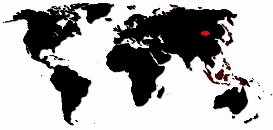 Back to Letterboxing 
WWW's Placed: 4-6-03 Same starting point as Thomas Knowlton, Ashford CT This box was made to be done on the way back to your car after doing the If you are doing this single letterbox: Follow Knowlton Hill Road north from the parking area .3 miles to the yellow blazes on the left of the road. From here you are at the same point as the Thomas Knowlton Letterbox clues leave off. From the end of the clues for the Thomas
Knowlton Letterbox of Ashford: The Mongolian Death Worm The Mongolian death worm, first reported in 1929 is also known as Allghoi Khorkhoi meaning intestine worm because of its shape. It is a fat, bright red huge worm measuring two to four feet in length and is likened to a cow’s intestine. It lives under the sand of the Gobi desert and is said to emerge during the hot months of June and July and to hibernate the rest of the year. The death worm is so feared by the inhabitants of Mongolia that they believe the mere mention of his name will bring bad luck. It kills it’s victims instantly by shooting a poisonous acidic liquid on them. The liquid, which the worm is able to shoot several feet, turns everything it touches yellow and corroded. It is also attracted to anything yellow. It is said to move about under the sand, and when it wants to kill someone, it moves half its length out of the sand. It starts to inflate it’s body. The bubble on its body keeps getting larger, and, in the end, the poison squirts out from it." This worm is also said to kill by emitting an electric shock that it also can send several feet. The worm became more widely known in 1990 by the Czech author Ivan Mackerle. He learned about it from a female student from Mongolia. The communist government in Mongolia banned any talk of death worm and tried to convince the people that it never existed. They also banned any expeditions in the area, calling the death worm, a fairy tale. After the fall of Communism in Mongolia in 1990, it was evident that they did not succeed in changing the minds of the people. Mackerle launched an expedition into the Gobi desert in 1990 in search of the worm but was unable to bring back any evidence except for more testimonials. Mackerle has reasoned that the creature might be a creature that is known as a skink. A skink is a strange variety of lizard whose head is hard to distinguish from its tail. Skinks also live buried under desert sands. But they have four stubby legs and scales, unlike the reportedly smooth-bodied Mongolian death worm. Mackerle has also suggested that it could be a type of lizard called the worm lizard, although that species is not poisonous. Among lizards, only the Mexican beaded lizard and the gila monster possess poisonous venom, but they do not squirt it, and their venom definitely is not instantly lethal on contact. It has also been suggested that the creature is some form of snake. The element of death from a distance and the intense heat of the Gobi Desert eliminates the possibility of most creatures. Could it be an unknown life form? Will one ever be captured? In the meantime, the legend continues. Find out more about the Mongolian Death Worm at the following websites. http://gordii0.tripod.com/NEW_PAGE_4.HTMhttp://www.expage.com/worm1234 http://definereal.tripod.com/unexp5.htm http://www.angelfire.com/pq/cryptozoologix/deathworm.html http://wintersteel.homestead.com/Unexplained_p2.html Before you set out, please read the waiver of responsibility and disclaimer. |